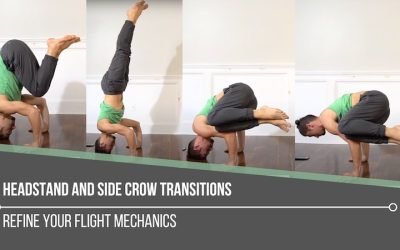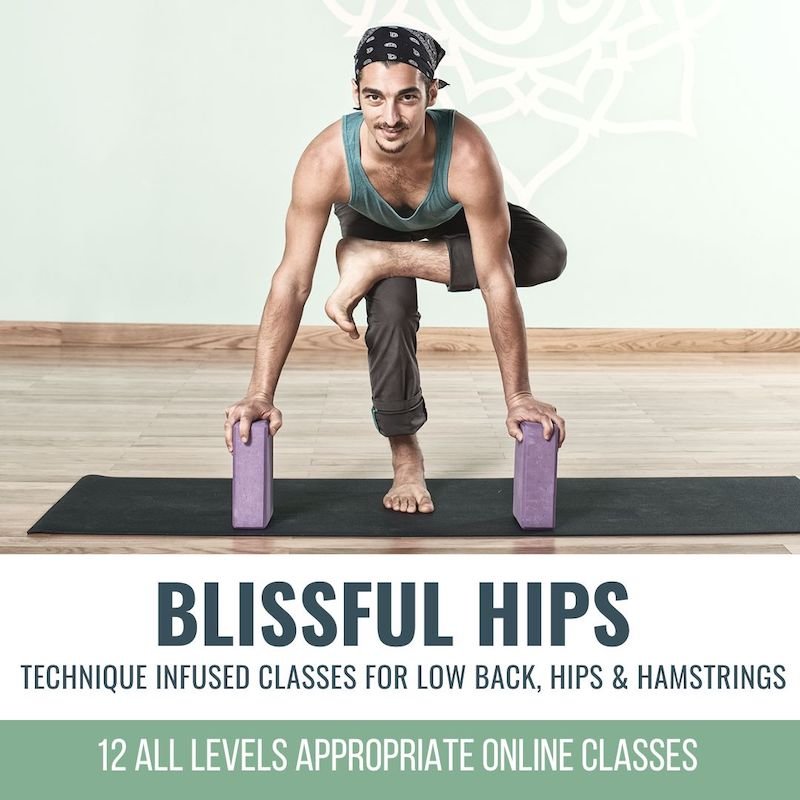Handstand ActionsLEAN, GRIP, PUSHHANDSTAND ACTIONS Handstand isn’t something we conquer in a single class, it’s a layered process that demands repetition and refinement. There are certain key handstand actions that are non-negotiable: lifting the shoulders up to the...
Target The Hip Joint
Target The Hip Joint
alignment
TARGET THE HIP JOINT
Unlike the hip joint, the movement available at the knee is primarily meant for flexion and extension. When we engage in hip opening postures in our yoga practice, there can be a great impact on both the hip and the knee. This will depend on many factors of course, so we must consider our individual situations and/or conditions in these areas. In order to avoid injury, direction from our healthcare practitioners takes priority before we can consider exploring on the yoga mat. Intention and how we move can have a great impact on avoiding knee strain, pain and/or injury. The postures and unique variations Matt shares in today’s video are practical and easily implemented. It’s all about how we move and target the hip joint that will reduce the negative impact that may occur in the knee.
THERAPEUTIC'S
REGISTRATION NOW OPEN
- 10 Chromatic Yoga practices with founder Matt Giordano
- Full length 75 minute classes
- Each Yoga class explore’s how to maintain optimal health in areas of the body that are prone to injury and chronic pain.
- Highly informative and educational classes for both practitioners and teachers.
- Each class includes warm ups, sun salutations, standing postures and cool down
- How to use props to modify or enhance benefits of each asana.
- Technique, biomechanics, and alignment at the forefront
- 12 Continuing Education hours with Yoga Alliance
- 12 Accredited Hours with the Chromatic School of Yoga
- Step-by-Step instruction for increased accessibility
- Improve strength, balance, flexibility, and proprioception
- Disclaimer #1: This is not designed as “Yoga Therapy” and will not diagnose or treat any specific ailments or injuries.
- Disclaimer #2: The purpose of this immersion is for education, exploration and understanding your options: there are no hard and fast solutions to injury’s that can be solved solely by practicing yoga
- Disclaimer #3: If you have an acute injury, be sure you have a doctors approval prior to practicing this immersion
LIZARD POSE EXERCISE
Hip opening requires external rotation at the hip joint. In Lizard pose, it’s easy to think about initiating this movement from the knee, but this is where it can go wrong for some of us. In the demonstration, Matt cues us to flex the foot and then rotate the shin and thigh together as a unit. In this Lizard pose exercise we are rotating inward and outward, which provides lots of practice and opportunity to move as a unit. This may reduce the chance of any strain on the ligaments of the knee. He clarifies that it doesn’t mean that if it does not move as a unit that there will in fact be strain or pain, but it’s the exploration of this movement that may prevent or assist in the reduction of strain. When we move like this, it’s actually encouraging the muscles of the inner thigh to turn on, which means that when we strengthen, we encourage more available movement.
WATCH THE VIDEO
TARGET THE HIP JOINT: REDUCE STRAIN IN THE KNEES
“COUNTERTOP” PIGEON
This variation of Pigeon pose is great because it offers less flexion at the hip joint. When there is more joint space, it eases up on the potential compression. In the video demonstration, the shin is facing the same direction as the toes. On the yoga mat in a more “traditional position” the pressure is put on the foot to medially rotate the shin, this is where we can experience more pressure on the inside of the knee or more strain on the outside. Of course we can add or back away from any amount of hip flexion by draping forward. Exploring like this can help us to understand where and when we are feeling more sensation at any given moment. We can use a countertop, but what we see in the video is Matt’s use of a stool along with 2 yoga blocks. Be creative and find what works. This will get us thinking more about our own bodies and how to support our own practice.
200 HOUR ONLINE TEACHER TRAINING
GET CERTIFIED & DEEPEN YOUR YOGA PRACTICE
- Deepen your yoga practice
- Build confidence speaking in front of groups in person and online
- Learn foundational class structures and templates
- Learn techniques for a wide range of yoga postures
- Get certified and highly qualified to teach yoga
- Yoga Alliance Globally Recognized Certification Program
MORE PIGEON VARIATIONS
Kneeling On A Chair
So what more can we do? If it’s too much to open the hip at standing level height, then this may be a better option. Here, Matt demonstrates how we can both deepen and vary the stretch. Changing the direction of where we lean over the front leg offers a deep stretch in different locations of the hip
Pigeon With A Block
When using a block for support in pigeon pose, it’s common that the block is placed under the buttock of the front leg for support, but we can actually encourage deeper range and better mobility of the hip joint by placing the block underneath the shin of the front leg.
The 2 key actions here are pushing the inner thigh down and out to the side, so that the thigh bone goes into deeper external rotation which shortens the tissues on the outer knee, again with the intention of reducing strain.
300 HOUR ONLINE TEACHER TRAINING
GET 500 HOUR CERTIFIED AS A MASTER TEACHER
Master your skill set as a teacher through refined techniques, anatomy, biomechanics, sequencing, philosophy, meditation techniques, theming, yoga business, and much more!
- Get 500 hour certified
- Learn anatomy, biomechanics, asana techniques
- Expand your teaching skills
- Masterful sequencing and verbal delivery
- Learn meditation and breathwork techniques
- Transformative tools: theming, dharma talks, satsang
WHAT’S THE POINT?
So, what’s the point of all of this exploration? The point is we can be more of an active participant in our own healing. Injury and pain are never fun or ideal, but what they can offer is an opportunity to learn more about how our bodies work and respond to different actions. Taking the time to do things like add and/or remove various props, engage in self adjustments, deepen or back away from stretch sensation while adding more strength, can all contribute to the reduction of pain in a given posture. The variations explored today can actually provide what we desire in hip opening postures (increased mobility along with stability).
Register for Matt’s current onlineTherapeutics immersion to uncover more possibilities when dealing with pain.
The 200 Hr. Teacher Training: Click Here to See the Next Start Date
The 300 Hr. Advanced Teacher Training: Click Here to See the Next Start Date
Article by Trish Curling
Video Extracted From: Therapeutics Immersion
ONLINE ANATOMY COURSE
- Accessible, exciting, and easy to learn
- Anatomy and biomechanics for yoga
- Appropriate for both teachers and students
- Learn joint alignment vs pose alignment
- Demystify yoga poses and transitions
- Release aches and pains
- Learn how to avoid common injuries
- Caters to all levels with modifications and props
- 20 hours Continued Education Credits with Yoga Alliance
- 20 hours toward Chromatic Yoga Certification and 300 Hour
- Lifetime access
Continue Learning
Handstand Actions
Handstand Mechanics
Handstand MechanicsINVERSIONHANDSTAND MECHANICS Stability, strength, and coordination come together in the pursuit of mastering handstand mechanics. One of the most critical foundations is internal rotation at the hip joints, which can aid with certain entries and...
Stable Sirsasana
Stable SirsasanaHEADSTANDSTABLE SIRSASANA Creating a stable Sirsasana is less about the final pose and more about the mechanics that lead us there. From weight transfer and spinal alignment to hamstring flexibility and shoulder engagement, each layer matters. Unlike...
Explore Hip Rotation
Explore Hip RotationSURYA YANTRASANAEXPLORE HIP ROTATION Hip rotation isn’t just an anatomical concept—it’s an open invitation to become more intimate with our body’s story. In yoga, we often live in lateral (external) rotation, especially in hip-opening postures....
Step Up Your Side Plank
Step Up Your Side PlankVASISTHASANASTEP UP YOUR SIDE PLANK Side Plank might look simple, but true proficiency starts in the details. One of the keys to refining the posture is learning how opposing muscle groups create an isometric contraction—a subtle engagement that...
Headstand and Side Crow Transitions
Headstand and Side Crow TransitionsPARSVA BAKASANAHEADSTAND AND SIDE CROW TRANSITIONS Mastery begins with mechanics, especially when it comes to headstand and side crow transitions. Each posture on its own demands control, coordination, and a deep understanding of...
THE FREE TECHNIQUE PACK
When You Subscribe, You Will Get Instant Access to
- the Technique Pack: 15 yoga pose breakdowns
- exclusive online course discounts
- exclusive blogs and videos













